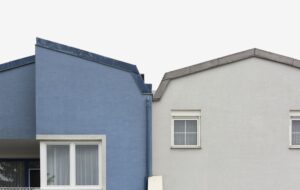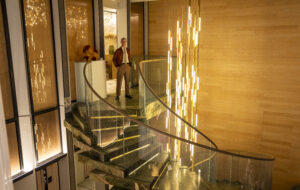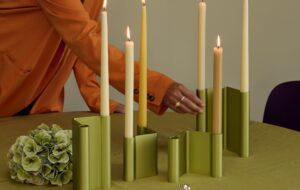


words Justin McGuirk
Terunobu Fujimori doesn’t look like a maverick.
The 60-year-old architect and professor at Tokyo University is sweetly avuncular and altogether unthreatening. And yet in Japanese architecture this self-styled “architectural detective” has assumed the mantle of the rebel, by turns respected as a thinker, feared as an iconoclast and derided as an eccentric.
Japanese architect Kengo Kuma sums up this somewhat paradoxical status, commenting: “Fujimori is destroying everything – Japanese tradition and methods. But he is between the serious and the joke.”
Fujimori is one of the most famous architects in Japan, widely recognised as a cultural commentator and TV talking head. However, he was little known abroad until he represented his country at last summer’s Venice Biennale, where he was the surprise hit. Amid the wall-to-wall statistics and urban planning diagrams – the Biennale’s theme was “the city”– the Japanese Pavilion was a delightful relief, albeit one straight out of left field. Here were oddly shaped houses sprouting leeks or dandelions and models of tea rooms carved out of tree stumps. They seemed like ancient buildings from an era that never occurred – the architectural equivalent of The Lord of the Rings. In an arguably reactionary gesture, they appeared to be rejecting the modern city altogether.
“I don’t like the contemporary urban environment, but I’m always interested in those who are experimental,” says Fujimori. We are sitting over two wooden platters of immaculate sushi in the Tanpopo (dandelion) House, his home in the western suburbs of Tokyo. Between the food, the tatami-mat floor and the hand-planed timber walls, this could be a pastiche of the Japanese idyll. But the house is a postmodern smorgasbord of traditional Japanese and Corbusian influences built of his trademark mix of natural materials – wood, stone, earth and plants (the roof is a grass and dandelion pyramid). However, with its concealed concrete frame, the house – along with other Fujimori buildings – has been criticised for using natural materials merely as a skin.
The interior of Tanpopo looks authentic to the layman but, against much resistance from his carpenters, Fujimori wilfully subverted all the traditional methods of making it, from the way the timber was cut to the way it was aligned. “Japanese craftsmen are not capable of doing anything that’s not pretty,” he says.
Tanpopo House, built in 1995, stands out in its patchwork suburban setting but it is less interesting than many of Fujimori’s more recent buildings, which embrace more wholeheartedly the imaginative potential of ancient structures for contemporary times. Buildings such as the Akino Fuku Art Museum (1997), the Futo-an pottery workshop (2001) and the Lamune hot spring house (2005), though by no means large, have an atavistic monumentality that is impossible to place. This is because they evoke, and are indeed inspired by, an incredibly diverse set of influences: 6th-century Japanese temples, the Neolithic stones of Callanish in Scotland, European thatched cottages and Malian rammed-earth mosques. “The Japanese tradition is in some ways mature,” says Fujimori, “but I’m interested in the period before this tradition became established. I believe that for humans all over the world the basic gesture was the hut, and this was the same everywhere before distinctive architectural styles emerged.”
Fujimori, like an architectural Carl Jung, is preoccupied with primitive archetypes, and the notion that these are a much more fundamental expression of the human spirit than, in the most extreme case, modernism. “People are not thinking in creating the contemporary environment; they’ re just repeating existing patterns and forms,” he says, later adding, “I’m more interested in buildings created by those who are not architects – they are always surprising.”
Fujimori has an affinity with outsider architecture, citing Watts Towers in LA and the self-decorated home of the Austrian artist Friedensreich Hundertwasser. But he has also been influenced by eccentrics who are very much part of the architectural canon, including the 18th-century Frenchman Claude-Nicolas Ledoux and that avatar of the Sixties, Peter Cook. In a crucial sense, Fujimori himself is an outsider, a figure entirely on the margins of the mainstream, and yet an influential one. According to Kengo Kuma, “The Japanese transparent style used to be the only possibility for young architects to follow, but after Fujimori the situation changed. Now people are beginning to think of alternative possibilities.”
It may be possible to discern the influence of Fujimori on the young Tokyo-based practice Atelier Bow-Wow (interviewed in icon 022), not least because Bow-Wow’s book on “pet architecture” is based on observing the marginalia that contribute to Tokyo’s chaotic urban make-up. Fujimori has made virtually a parallel career out of precisely this observational form of practice. The part of the Japanese Pavilion at the biennale that really tied it to the theme of the city was a hut woven out of rice twine housing a slide show by the ROJO (Roadway Observation) Society. As one of the key members of this group for 20 years, Fujimori has been documenting the traces of unintentional but naturally occurring patterns of behaviour in Tokyo. These might be the pattern made on a concrete wall by a branch scraping against it in the wind, or tracks left by cyclists following the same shortcut.
Much like the ancient forms of vernacular architecture that inspire him, these traces are things that few people pay attention to. I suggest, thinking of Robert Venturi and Denise Scott-Brown’s Learning from Las Vegas, that he and ROJO might have adopted the American architects’ strategies. “There is a resemblance, certainly,” he says, “but Venturi sought to highlight extremely visible parts of the city, whereas I sought to uncover aspects that are by and large invisible. I call this the urban unconscious.”
The origins of ROJO lay in an earlier group called the Tokyo Architectural Detective Agency, in which Fujimori and his colleagues patrolled the city in search of the earliest Western-style buildings. The result, a dozen years in the making, was his prize-winning work of urban history, Adventures of an Architectural Detective (1986). At this point, Fujimori was still an architectural historian, a phase of his career that clearly determined what is essentially a backward-looking perspective. He didn’t turn to practice until his early forties, when he built the Jinchokan Moriya Historical Museum in his hometown in the mountainous Nagano region, in 1991.
Fujimori arrived at architecture late but he was initiated early. “When I was eight years old my parents rebuilt their house and the carpenter came and lived with us,” he says. “Every time I came home from school I was made to assist him, and it took a whole year.” This hands-on experience may have sewn his later taste for natural materials, but his initial forays into architecture were more bookish. Not counting the Archigram-inspired bridge he designed for his graduation project, Fujimori’s first real work was a book on the planning of Tokyo during the Meiji period. Set after the 1923 earthquake, it is significant that this was a time when people were patching together structures out of whatever materials they could – a time, as Fujimori puts it, “when architects’ dreams had collapsed”.
At face value, Fujimori’s neo-primitive architecture and his photographic and written observations of the city don’t appear to have much of a connection to each other. In so far as there is a link, it lies in his belief that the most interesting aspects of cities and the most compelling buildings are not the product of architects. The smooth surfaces and clinical thinking representative of first modernism and now digital design, as far as Fujimori is concerned, lack essential character.
Now sitting on the grassy pinnacle of his roof, surveying the neighbourhood, it occurs to me that what Fujimori is after is uniqueness, and I ask whether he is in fact wilfully individualistic. He smiles, struggling with the idea, and says, “I’m a modern person so I suppose I’m individual, but it’s not just wilfulness.”
















